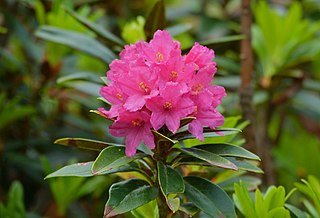
The Golden Globe Award for Best Supporting Actor – Motion Picture is a Golden Globe Award that was first awarded by the Hollywood Foreign Press Association in 1944 for a performance in a motion picture released in the previous year. The formal title has varied since its inception; since 2005, the award has officially been called "Best Performance by an Actor in a Supporting Role in a Motion Picture". Six actors have won the award twice: Richard Attenborough, Edmund Gwenn, Martin Landau, Edmond O'Brien, Brad Pitt, and Christoph Waltz.

Christoph Schubert is a German former professional ice hockey player. Schubert played over 300 games in the National Hockey League (NHL) for the Atlanta Thrashers and Ottawa Senators from 2005 to 2010.

Rhododendron ferrugineum, the alpenrose, snow-rose, or rusty-leaved alpenrose is an evergreen shrub that grows just above the tree line in the Alps, Pyrenees, Jura and northern Apennines, on acid soils. It is the type species for the genus Rhododendron.

The rusty carpetshark is a carpetshark of the family Parascylliidae found off southern Australia between latitudes 31°S and 41°S near the ocean floor on the continental shelf. It inhabits rocky reefs and seagrass beds 5–150 m (16–492 ft) in depth by night, hiding in caves by day. Its length is up to 80 cm (2.6 ft) TL and it feeds on crustaceans and molluscs. Reproduction is oviparous, with pups being born at 17 cm (6.7 in) in length.

Christoph Waltz is an Austrian and German actor. Primarily active in the United States, he gained international recognition for his portrayal of villainous and supporting roles in English-language films. His accolades include two Academy Awards, two Golden Globe Awards, two BAFTA Awards, and two Screen Actors Guild Awards.

Parascyllium is a genus of carpetsharks in the family Parascylliidae. Species in this genus are distributed in waters around Australia.

Hydnellum is a genus of tooth fungi in the family Bankeraceae. Widely distributed in the Northern Hemisphere, the genus contains around 40 species. The fruitbodies of its members grow by slowly enveloping nearby bits of grass and vegetation. There is great variability in the form of Hydnellum fruitbodies, which are greatly influenced by environmental conditions such as rainfall and humidity, drying winds, and temperature. They are too tough and woody to eat comfortably. Several species have become the focus of increasing conservation concern following widespread declines in abundance.

Dendrolirium ferrugineum, synonym Eria ferruginea, is a species of orchid. It is native to Bhutan and Assam in the eastern Himalayas.

Lasiopetalum ferrugineum, commonly known as rusty velvet-bush, is a species of flowering plant in the mallow family and is endemic to eastern Australia. Growing up to a metre tall, much of the plant is covered in rusty hairs. It is found in forest and heathland.

Hydnellum ferrugineum, commonly known as the mealy tooth or the reddish-brown corky spine fungus, is a species of tooth fungus in the family Bankeraceae. A widely distributed species, it is found in north Africa, Asia, Europe, and North America. The fungus fruits on the ground singly or in clusters in conifer forest, usually in poor or sandy soil. Fruit bodies are somewhat top-shaped, measuring 3–10 cm (1–4 in) in diameter. Their velvety surfaces, initially white to pink, sometimes exude drops of red liquid. The lower surface of the fruit body features white to reddish-brown spines up to 6 mm long. Mature fruit bodies become dark reddish brown in color, and are then difficult to distinguish from other similar Hydnellum species. H. ferrugineum forms a mat of mycelia in the humus and upper soil where it grows. The presence of the fungus changes the characteristics of the soil, making it more podzolized.
Palaquium ferrugineum is a tree in the family Sapotaceae. The specific epithet ferrugineum means 'rusty coloured', referring to the indumentum.
Xanthophyllum ferrugineum is a tree in the family Polygalaceae. The specific epithet ferrugineum is from the Latin meaning 'rust-coloured', referring to the inflorescences.

Christoph Zimmermann is a German professional footballer who plays as a centre-back for 2. Bundesliga club Darmstadt 98.

Rhododendron myrtifolium, the myrtle-leaved rhododendron, (Eastern) Carpathian rhododendron, Chervona ruta or mountain peony is a species of flowering plant in the family Ericaceae. This evergreen shrub is common in some high mountain ranges of Eastern Europe, particularly Bulgaria, Romania and Ukraine.

Abstract: The Art of Design is a Netflix original documentary series highlighting artists in the field of design. It was released on Netflix on February 10, 2017. The series was created by former Wired editor-in-chief Scott Dadich.
Plesiomma is a genus of robber flies in the family Asilidae. There are at least 20 described species in Plesiomma.
Aulonium ferrugineum is a species of cylindrical bark beetle in the family Zopheridae. It is found in North America.
Diploplectron is a genus of wasps in the family Astatidae. There are more than 20 described species in Diploplectron.

Christoph Baumgartner is an Austrian professional footballer who plays as a attacking midfielder and forward for Bundesliga club RB Leipzig and the Austria national team.

Acalitus ferrugineum is a species of eriophyid mite. This microscopic organism induces erineum galls on the leaves of American beech, and is known from the United States and Canada.














